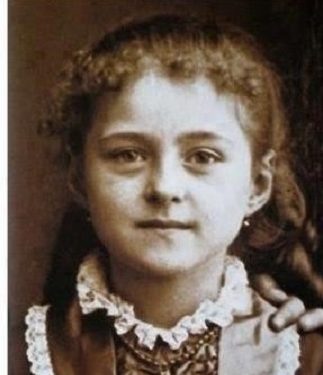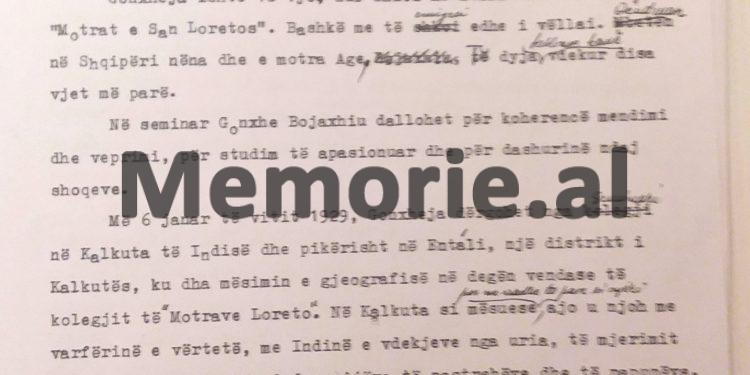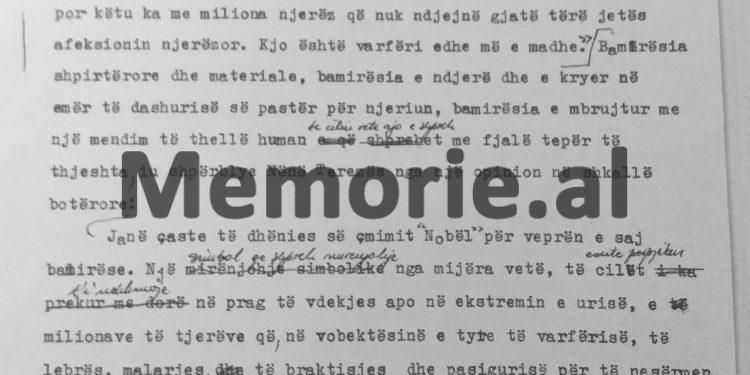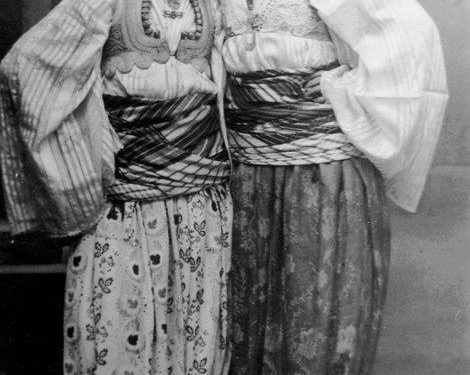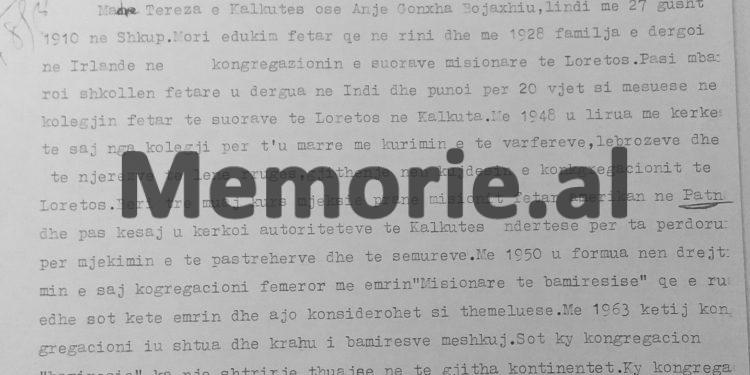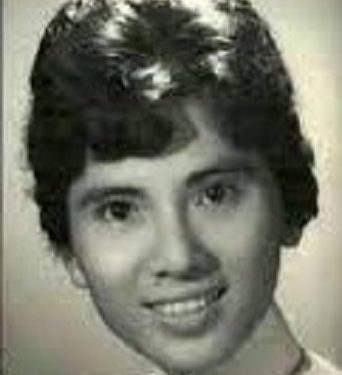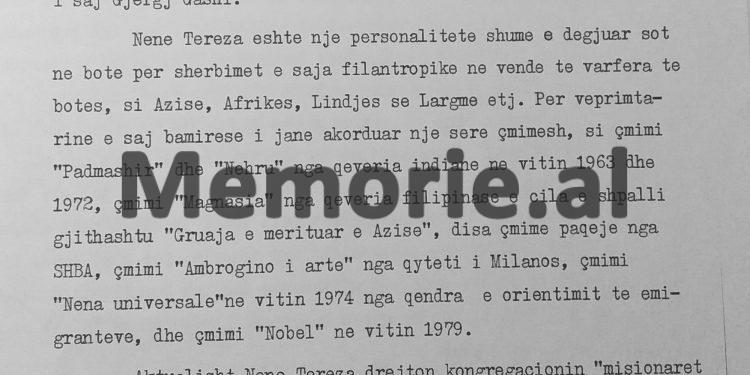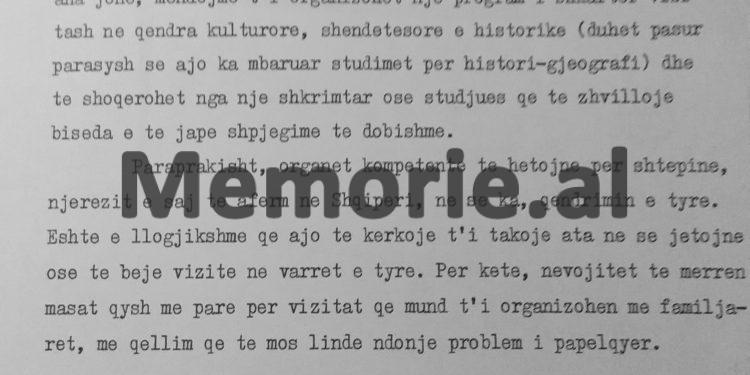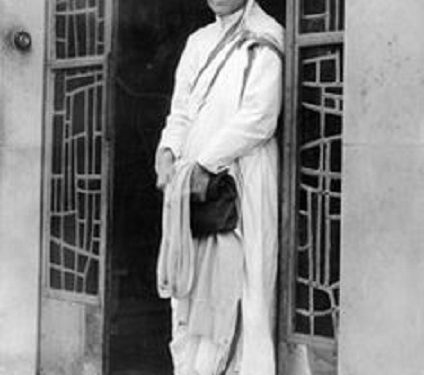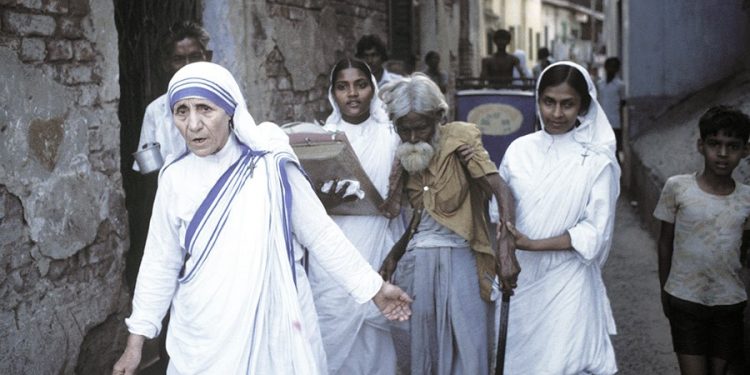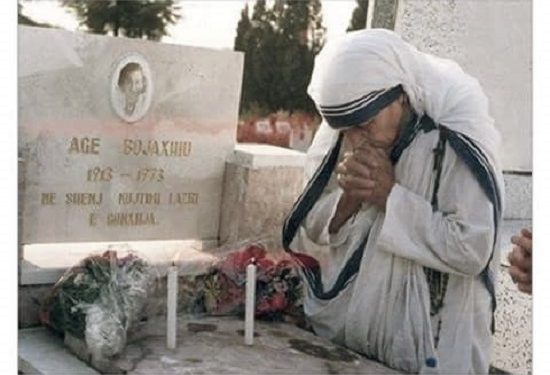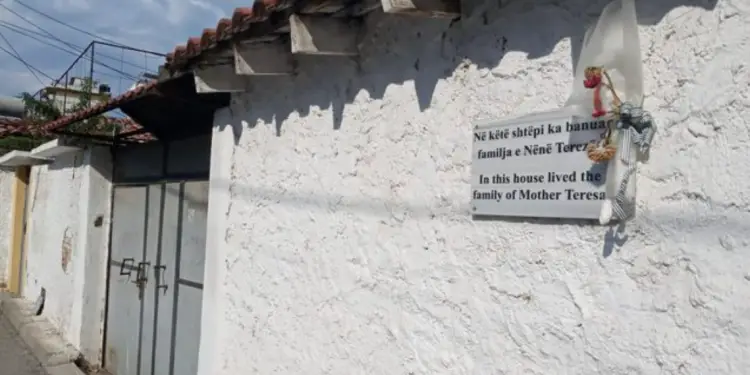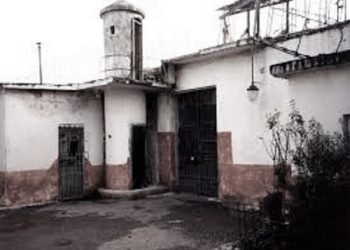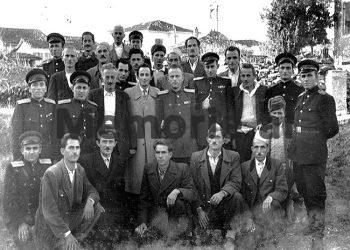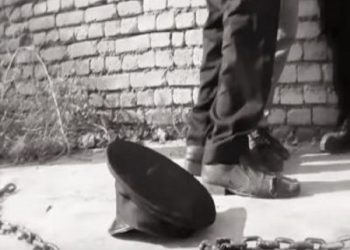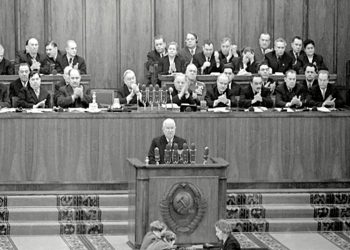Dashnor Kaloçi
Second part
Memorie.al publishes some archival documents with the logo “Top secret” recently released from the Archive of the Ministry of Foreign Affairs in Tirana and the Central State Archive, which belong to a period of time from (1969-1991), where there is a correspondence between the Ministry of Foreign Affairs with the Central Committee of the ALP and some Albanian diplomatic missions accredited in the West, such as Rome, Paris, etc., with telegrams, reports, information, orders, diplomatic notes, invitations, articles, newspapers, press leaflets, photographs, etc., where it is about Mother Teresa of Calcutta, the famous saint of Albanian origin, Gonxhe Bojaxhi, winner of the Nobel Peace Prize in 1979, which since 1969, through French channels and Italian Diplomats , I asked official Tirana to come to Albania, to her homeland, to visit her mother, Roza Bojaxhi, who at that time was 86 years old and ill, as well as her sister, Age, who lived in Tirana. All the complete documentation is made public for the first time by Memorie.al, where light is shed on all the charitable activity of the famous saint, to help the poor around the world and her extraordinary desire to help her compatriots in Albania. communist rule, as well as the total silence of official Tirana and the high communist leadership of that time, led by Ramiz Alia and Nexhmije Hoxha, who under various pretexts prevented her arrival in Albania and allowed it only in 1989, thanks to pressure great international!
Continues from the previous number
The report of the Albanian Embassy in Rome for the Ministry of Foreign Affairs in Tirana, with the text of a TV show, realized for Mother Teresa
TV show Year 1989
Mother Teresa
File 1204
Mother Teresa… Albanian… born in the city of Skopje, in 1910. There are two sisters and a brother. Her real name is Gonxhe, the surname Bojaxhiu. The mother was distinguished for strong character and great compassion. Little Gonxhja, an agile child, full of liveliness and joy.
Her father was involved in construction activities. He died very young at the age of 42. The family remained in great poverty.
Gonxheja was 18 years old when he went abroad to the “Sisters of San Loreto” seminary. Her brother also emigrated with her. Mother and sister Age stayed in Albania. The two died together a few years ago.
In the seminar Gonxhe Bojaxhi is distinguished for the coherence of thought and action, for the passionate study and for the love for friends.
On January 6, 1929, Gonxheja was sent from the Seminary in Calcutta, India, to Antalya, a district of Calcutta, where he taught geography at the local branch of the Loreto Sisters College. In Calcutta, as a teacher but primarily as a human being, she was introduced to true poverty, to India of starvation, misery, and the miserable fate of hundreds of thousands of homeless and unemployed.
Her human nature was greatly influenced by this bitter reality. She further extended her love for students and colleagues. In her heart and mind, rooted the feeling that as a human being, she had to personally do something more for man, for the poor, the sick, the vulnerable.
This feeling, now turned into a final goal, gave her the courage to leave the “Loreto Sisters” in September 1948 and dedicate herself to charity; she was 38 years old isolated in a hospital in West Beirut. Her attempt succeeded. The children were given the necessary assistance. These touching scenes sound like a cry for peace in a Lebanon, where the noise and fire of artillery is devastating for days more and more human life.
“Maybe,” she says at this meeting at Harvard University, “here in America,” it’s not a problem to the extreme poverty of a morsel of bread, but there are millions of people here who do not feel a human love life. This is even greater poverty. Spiritual and material charity, charity felt and done in the name of pure love for man, charity imbued with a deep human thought, which she herself expresses in very simple words, was rewarded to Mother Teresa with an opinion in world scale:
These are the Nobel Prize moments for her charitable work. A symbol expressing gratitude to the thousands who have tried to help on the brink of death, or to the extreme of hunger, of millions of others who, in their misery of poverty, leprosy, malaria, abandonment and insecurity for the future, we see in action of Mother Teresa, an act of love for humanity that challenges in some way the great injustices of society.
Already, at the age of 79, Mother Teresa makes this journey to the homeland, to touch the earth, to see the graves of her mother and sister, to get acquainted with a reality that above all values and exalts human values.
This train to Calcutta would take him to the many stations of humanity, hunger and death. It is located in one of the poorest neighborhoods, in this modest palace. Nearby are some of her former students. In this period, India was in the wave of nationalist unrest. Consequences of the Civil War: Thousands of refugees die on the streets.
Mother Teresa, this is already the name by which everyone knows her, tries to be close to as many people as possible who die of hunger, to help, with kind words, with compassionate hands, with every food and medical help.
Thus is established the charity center in Calcutta of misery. It is a modest organization, but it has its own statute and a humane motto: “It does not matter how much you do and how much you give to the poor, it matters how much sincerity and love for man, put into your action.” organization, according to the statute, the only source are the alms of particular people, not of governments, other organizations or even the church.
Only individual contributions are accepted: – Man for man – a philosophy of charity that, thanks to Mother Teresa, gradually began to spread not only in India but also in other parts of the world, where poverty and misery wreak havoc. Always based in Calcutta, India, it undertakes several trips, to Latin American countries, to Africa, but also to Europe and the US, to areas such as the slums of the Bronx of New York.
Even in Lebanon devastated by the wounds of war, Mother Teresa takes humanitarian action. Located here during the period when Israeli troops besieged Beirut a few years ago, it intervenes with its authority for several hours of ceasefire, so that the people of the Red Cross can help some disabled children.
Report of the Albanian ambassador in Rome, Dashnor Dervishi, sent to the Ministry of Foreign Affairs in Tirana, with biographical data about Mother Teresa, taken from the book dedicated to her
R.P.S.SH.
Ministry of Foreign Affairs Rome 10 June 1989
Embassy – Rome
No.370
MINISTRY OF FOREIGN AFFAIRS
(First Directorate)
T I R A N E
Attached we send you the book about Teresa of Calcutta and a brief note on her life and activity.
Mother Teresa of Calcutta or Anje Gonxha Bojaxhiu was born on August 27, 1910 in Skopje. She received her religious education in her youth and in 1928, her family sent her to Ireland to join the Loretto Missionary Congregation. After graduating from religious school, she was sent to India and worked for 20 years as a teacher at the Loreto Suora Religious College in Calcutta.
In 1948, at her request, she was released from college to care for the poor, lepers, and the homeless, always under the care of the Loreto Congregation. She took a three-month medical course at the American Religious Mission in Patn… and then asked the Calcutta authorities for a building she would use to treat the homeless and sick.
In 1950, under her leadership, a congregation of women called the “Missionaries of Charity” was formed, which still retains this name and is considered the founder. In 1963, male charities joined the congregation. Today, this “charitable” congregation extends to almost every continent. This congregation, in addition to the religious side, relies on charitable deeds, is considered as a helper of the poor, orphans, abandoned, people in distress, loneliness, the sick, etc.
The motto of this congregation is the spiritual recovery of man even in the last moments of life. Teresa taught her missionaries the motto: “Always offer a happy smile to children, to the poor, to all who suffer. Give them not only the savings, but also the heart “, which was accepted by all charitable missions in the service of the religious work of the church.
The Indian government in 1963 awarded her the Padmashri Peace Prize and in 1972 the Nehru Prize. In 1963 the Philippine government awarded her the Magsaisa Prize and declared her “Asia’s most deserving woman”. In 1971, the US awarded her several Peace Prizes, while the American Catholic University awarded her the honorary title. In 1973 she was honored by the city of Milan with the “Golden Ambrogino” award, while in 1974 she was honored with the “Universal Mother” award by the Immigrant Orientation Center of the Religious University of Canada and in 1979 she was honored with the Laura Award of Honor won the Nobel Peace Prize.
She currently leads the congregation of “charitable missionaries” and travels to all the places where there are missions and their centers. Three years ago, she telephoned the embassy directly and expressed a desire to go to Albania, as a mere visitor, to pay homage to her mother’s grave (her father said he had been killed by Serbs). At that time, the Italian ambassador to FAO requested that Teresa come to Albania for a few days. Recently, many Arbëresh have repeated Teresa’s desire to go to Albania, to see the land of her ancestors.
Among others, prof. Catapano spoke with Gonxhe Bojaxhiu and brought us her greeting. According to him, she wants to come to Albania like any visitor, not under the guise of religion, not with fuss, to see her mother’s grave, before she dies. Prof. Catapano says she is ready to accompany her during her private visit to Albania.
Ambassador
(Dashnor Dervishi)
Information of the State Security Directorate, sent to the Ministry of Foreign Affairs, regarding the preparation of Mother Teresa’s visit to Albania
First Directorate
Information Year 1989
The President of the Association of Writers and Artists of Arbëreshë and the friend of our country, Prof. Giuseppe Del Gaudio, through a letter sent to our ambassador in Rome, express the wish of Mother Teresa, “to kiss the mother earth, before she dies”. In this visit she will be accompanied by Giuseppe Del Gaudio and her friend and companion Gjergj Gashi.
Mother Teresa is a well-known personality in the world today, for her philanthropic services in poor countries of the world such as Asia, Africa, the Far East, etc. For her charitable work she has been awarded a number of awards, such as the Padmashir Award and the Nehru Award by the Indian Government in 1963 and 1972, the Magnasia Award by the Philippine Government which also declared her a “Deserved Woman”. of Asia “, several US Peace Prizes, the” Golden Ambrogino “Prize from Milan, the” Universal Mother “Prize in 1974 from the Center for Immigrant Orientation, and the Nobel Prize in 1979.
Currently, Mother Teresa leads the Congregation for the Doctrine of the Faith. According to Arbëresh, friends of our country, Mother Teresa proudly mentions everywhere the fact that she is Albanian, has never spoken against our country, enjoys great sympathy in the circle of Arbëresh and Kosovars, because of its origin and has contributed morally and materially to support the Kosovo issue.
Her visit to Albania, previously requested by her, the Arbëresh emphasize, would serve as an obstacle to any possible campaign against human rights in Albania, if she were to die, without being allowed to see her homeland.
Allowing Mother Teresa to come to our country, in conditions when the issue of respect for human rights is on the agenda today and tends to grow more and more, would be a strong argument in our hand, to oppose facts the attacks and pressures exerted on us by various hostile circles and organisms.
Her arrival in our country will certainly not pass without a fuss and in this context will indirectly fall down and many of the claims and slanders that in our country, believers and clergy, are persecuted and killed. In addition, it will also give a hand to the friends of our country, to defend us with arguments, in international human rights organizations, in which our country does not participate.
We think that there will be a positive effect on many benevolent friends of our country, who have sympathy for Albania, despite our attitude towards religion. This will also be sensitive to the Arbëresh community in Italy, as well as the Kosovar mass, which it is said to have supported.
Her arrival in Albania can be used by us to show her the true reality of our country, the peace and tranquility in which our people live, their achievements, the care shown for education, culture, tradition, etc. This will be a confrontation of reality with what the Vatican has slandered so far.
But of course it is not excluded that her visit to our country is used by malicious circles to prove that allegedly Albania is making concessions on issues of principle, such as the attitude towards religion. This can be followed as a whisper in our opinion, regarding religion, etc.
In case her visit will take place, without publicity on our part, we plan to organize a short program of visits to cultural, historical, and health centers (it should be borne in mind that she has completed her studies in history-geography ) and be accompanied by a writer or researcher, to have conversations and give useful explanations.
In advance, the competent bodies should investigate the home of her relatives in Albania, if there is their residence. It is logical for her to ask to meet them if they live, or to visit their graves. For this, it is necessary to take measures as soon as possible, for visits that can be organized with family members, in order not to cause any unpleasant problems./Memorie.al
Tirana on June 17, 1989
Continues in the next issue




